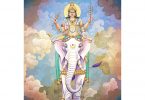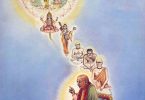Q. 1. I have a question regarding a statement I heard in the past and remembered recently:
Seeming paradoxes are found in various places in scripture. For instance, in one scripture it may be said “all the forms of the Lord are equal,” while in another it may be said, “no other form of the Lord is as complete as Krishna.” While he didn’t use this particular example, I have heard from an advanced Vaishnava that such “contradictions” force us as readers to stop and contemplate instead of speeding along thinking that we understand things. I’m wondering if this understanding is correct and if you can elaborate to provide clearer understanding?
Answer by Romapada Swami: As you have hinted within your question, what ‘appears’ to be paradoxes or contradictions within scripture are only seemingly so; factually, there is no real contradiction.
In some instances, scriptures are deliberately filled with apparent double-talk. A typical example is the language of the Upanishads: e.g., “The Supreme Lord walks and does not walk. He is far away, but He is very near as well. He is within everything, and yet He is outside of everything.” (Isopanishad Mantra 5) Such contradictory statements are provided to indicate His inconceivable, transcendental nature. He walks, but His walking is nothing like the walking within this mundane realm. So, thanks to these paradoxes, we are induced to reconsider and reform the deep-rooted material conceptions in our mind when contemplating the Supreme Absolute Truth.
It is not necessarily that all such contradictions are purposefully presented by the scriptures in order to get us to contemplate. It is just the nature of Absolute Truth, which appears to us to be contradictory when we try to capture it within the limited vocabulary of language or within the limited framework of our material mind and intelligence. But by patient and repeated aural reception of the whole message, and by receiving clarification from a realized soul, such contradictions become resolved. The Bhaktivedanta Purports explicitly serve this purpose!
Some of these apparent contradictions, which often become topics of debate among inter-faith discussions, are resolved by understanding the example of higher and lower level mathematics. One may learn in a simple way in elementary math that it is not possible to subtract a bigger number from a smaller one, but as one progressively learns the concepts of negative numbers, rational and irrational numbers, imaginary numbers and so on, instead of seeing contradictions, one’s understanding becomes wider and deeper.
Often, what appears as contradiction is due to our own lack of understanding or preconceptions about what God or spiritual life must look like. Sometimes it is seen that even when Reality is presented in a very simple and straightforward manner, people find it hard to reconcile. A common example is in understanding how Krishna favors His devotees like the Pandavas. God is supposed to be impartial and yet He gives different rewards to different living entities and He particularly seems to favor and take the side of His devotees. This is not a contradiction, but appears to be so because of not understanding that He EQUALLY reciprocates with everyone as they approach Him. As one’s spiritual understanding and realization matures, such things cease to be contradictions but rather become another impetus for deeply appreciating the qualities of Krishna.
Another way to understand the same thing is that all contradictions are reconciled in the Supreme Personality of Godhead, Krishna. That is to say, He is simultaneously equal and yet different from all of His other expansions, He is simultaneously impartial and yet partial to His devotees, He is simultaneously present everywhere and yet never leaves His abode in Vrindavan and so on.
Another fundamental reason for seeing contradictions is often due to not understanding Krishna’s Personal nature; Krishna is a Person and He has desires, likes and dislikes, and freedom. Behind all the variegated arrangements one can experience within the material creation, and behind all His dealings with different living entities — is Krishna’s very personal, loving, compassionate nature and inimitable capacity in reciprocating with His different parts and parcels. How He acts and why He does certain things may not always follow a set pattern or formula. Thus, His will is said to be “inscrutable”.
The common tendency amongst those educated in the modern school of rationalism is to try to subject everything, including spiritual topics, to analysis and rationalization and reductionism — but these tools fail us miserably in trying to understand Spirit. You are likely to be familiar with the famous example of the five blind men — each of them came up with completely contradictory pictures of the elephant, while in fact none of them were close to whole truth. Our approach to scripture is often like those blind men, and thus we run into many “contradictions”. Therefore, in order to learn the truth, it is indispensable to approach a seeing man, i.e. a self-realized soul. Under the guidance of such a spiritual master, one can systematically learn to reconcile all contradictions and see the Whole Truth.
This brings us to your next question.
Q. 2. Also, in light of the above it seems necessary at some point for those engaged in hearing and reading to make references between guru, sadhu and shastra in order to develop correct understanding. However, I’ve also heard that one should hear from a single source in order to avoid confusion. This is a seeming contradiction in itself, which leads to the question: when is the right time to implement this system of understanding?
Answer by Romapada Swami: Once again, there is no contradiction in this principle, although there seems to be! The bona fide sadhu, shastra and guru are always in line with each other – the three-point check involves observing how each of them reinforces each other, which solidifies our faith in each of these.
Being familiar with shastra and previous saintly persons is essential to ascertain a bona fide guru in the first place, and yet factually one can have no access to the first two without the help of the latter. For instance, how would we know what is the bona fide version or meaning of Bhagavad-gita, without the help of a faithful representative of Bhagavad-gita in disciplic succession, such as Srila Prabhupada? But as we hear or study Prabhupada’s books and observe his life, we see that he had no personal opinion to offer; both his prachar as well as achar were perfectly in line with and bringing to life the messages of Bhagavad-gita and the teachings of the previous mahajanas which he presented. Thus, we can affirm that “Here is a bona fide guru”, based on the authority of sadhu and shastra, not just by personal or popular opinion. Simultaneously, the personal purity, empowerment and example of Prabhupada’s life reinforces our faith and understanding in the validity and practicability of shastra and the teachings of previous acharyas. Thus, reference to sadhu-shastra-and-guru help reinforce each other, and yet simultaneously it is through one’s personal spiritual master that one can gain access to sadhu and shastra, as well as properly understand how to practically and systematically apply their teachings in our personal life.
The three-point check is rendered futile if one doesn’t develop absolute faith in any one of them. Once having ascertained a bona fide spiritual master – in the light of sadhu and shastra — and having developed firm confidence that here is a transparent representative of Krishna and the disciplic succession, one should then set aside all of one’s personal conceptions and hear from the spiritual master in order to learn the proper conclusions of scriptures. This firm faith is the fulcrum or basis from which one is able to overcome all contradictions. Please note that the disciple still appreciates the spiritual master in the light of sadhu and shastra, not independently; but his reference to sadhu and shastra is not exactly for the purpose of perpetual cross-checking. Such an attempt to try to validate and substantiate every action or statement of guru or sadhu or shastra is not helpful when done without proper guidance – it could lead one into the realm of “apparent contradictions” discussed above, and weaken one’s faith, especially for the neophyte student who does not have deep grasp of scripture and spiritual principles.
By hearing from one spiritual authority, especially in the beginning stages or when one is riddled with contradictions, one develops the ability to see in synthesis. Isopanishad uses the word ‘anupasyatah’, or seeing through authority, by which one can become undisturbed by dualities. (Iso Mantra 7) The spiritual master knows the mentality of the disciple – what his doubts and possible areas of confusions could be – and thus he helps to address them and trains the disciple to see the world through the eyes of scriptures. Having gained the maturity and ability to see everything in synthesis, then one is able to hear from multiple sources and not become disturbed, because of having been troroughly trained FIRST to see the underlying essential unity.







